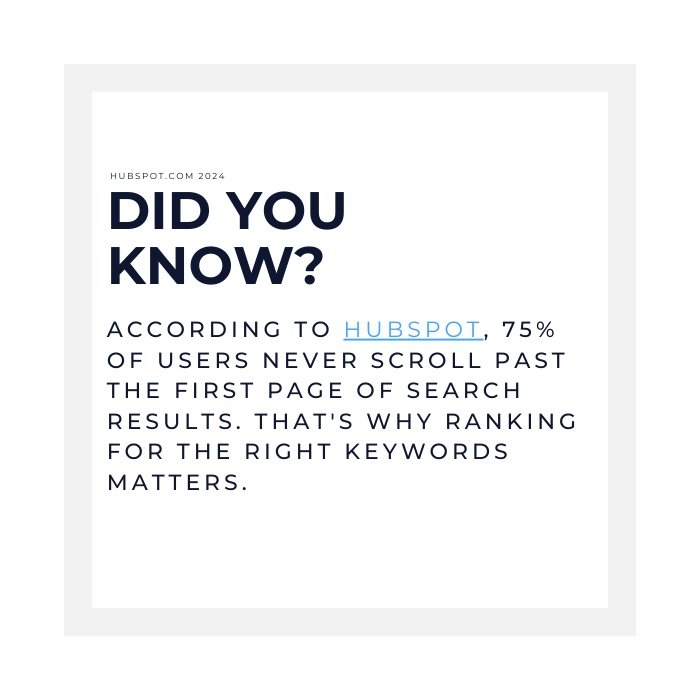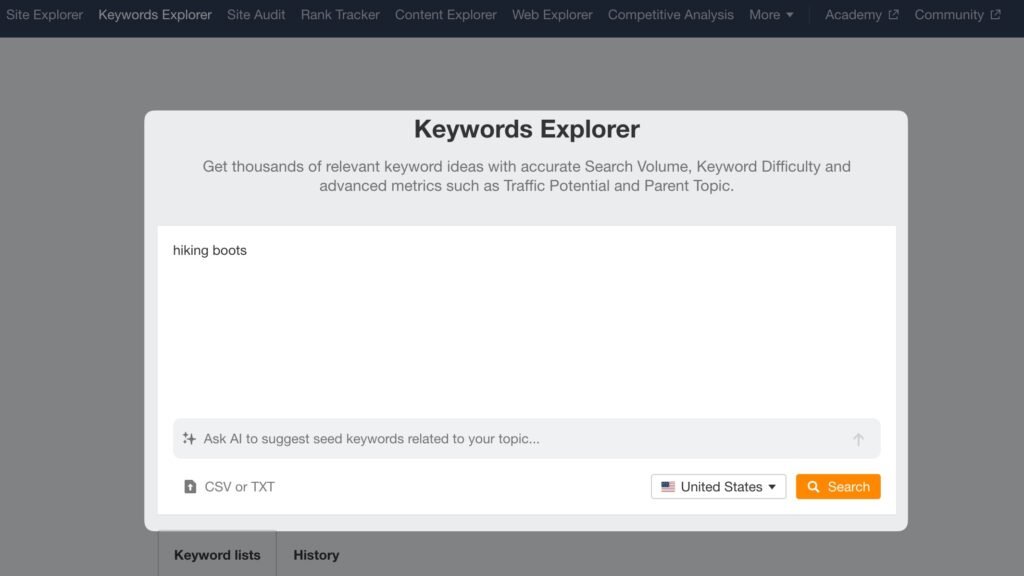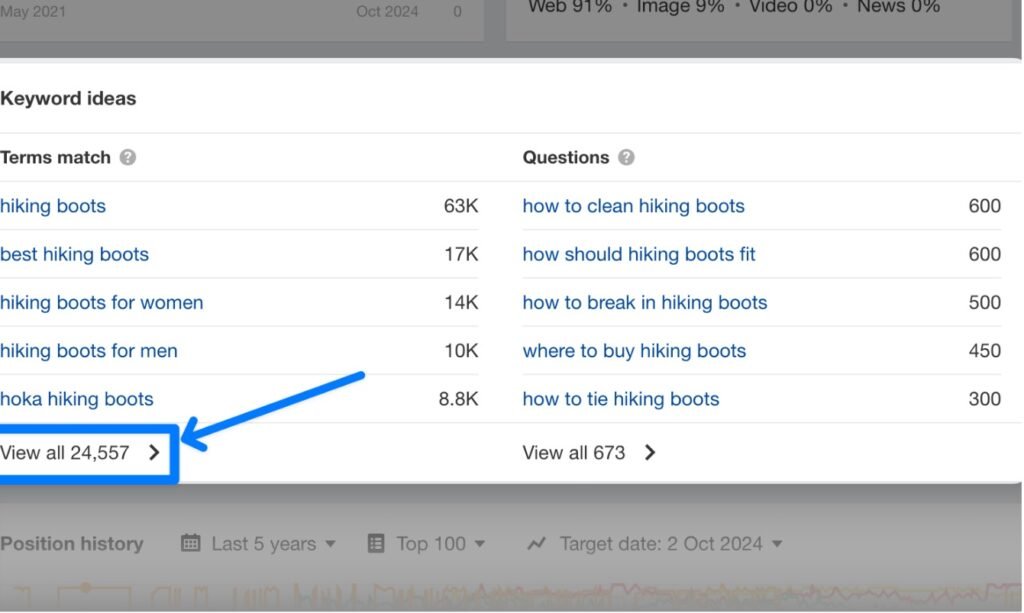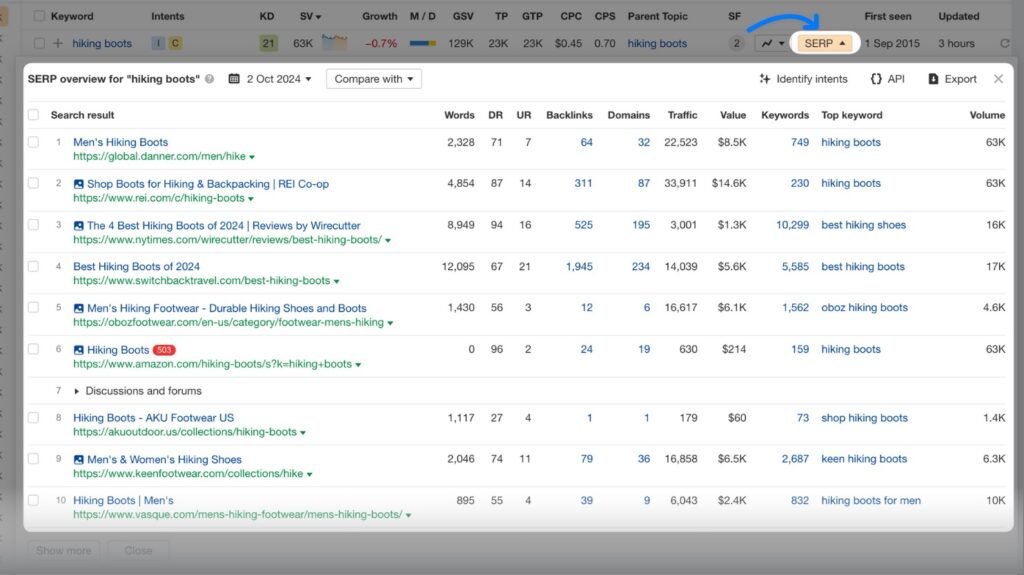|
Getting your Trinity Audio player ready...
|
Few days ago, while chatting with a fellow friend about all SEO trends, and digital marketing in general, we realized that one key element connects it all:
effective keyword research!
NO KEYWORD RESEARCH, NO RESULTS!

In fact, over 90% of marketers ( including me ) say that keyword research is crucial for their content strategy, highlighting its importance in attracting the right audience!
It’s Hristijan, your SEO buddy, and today I came across some WordPress challenges and I would love to share some key points on keyword research for your WordPress blog.
First thing first.
We all know, keyword research is the cornerstone of your WordPress blog.
Let’s put it in a definition: That is the keyword research process of finding words and phases that people type into Google when looking for information.
These keywords will help you in creating content that speaks with your audience and one that ranks.
Let’s get into how you can do keyword research for your WordPress blog with the best keyword research tools.
What is Keyword Research and Why is That Important for Your Business?
Write down: Keyword research is about knowing what words or phrases people are searching for online and they are clues as to what your potential readers are looking for.
Knowing what your audience wants, informs you on how to write content that answers questions, solves problems, or helps them reach a decision.
Suppose somebody types in “best budget hiking boots”; they want a list of hiking boots that are cheap.
If your blog post is optimized for this keyword, they will likely find your article.

Did you know that according to HubSpot, 75% of users never scroll past the first page of search results. That’s why ranking for the right keywords matters.
You are probably already googling on how to do keyword research, so the following chapter is right about that.
How to Do Keyword Research
As you can notice, keyword targeting takes a bit of extra legwork before you have even written a blog post.
Here is a step-by-step guide ( personally, the strategy that works best for me ) in finding those keywords to target.
1. Use Seed Keyword
First, you are going to have to take advantage of the seed keyword.
The seed keyword is very general and related to your blog’s niche.
It is usually small, uncomplicated words or phrases, including but not limited to “hiking boots” or “WordPress themes.”
Jot down a list of these seed keywords you will start with on your blog.
- Audience Awareness: What do they want to know? What are they trying to do ?
- Look at Your Competitors: Use the best keyword research tools like Ahrefs or SEMrush to see what keywords your competitors are ranking for.
- Use Google’s Autocomplete Feature: Type a seed keyword into Google and see what comes up in the autocomplete keyword suggestions. This shows what people search for related to that keyword.
2. Expand Your Keywords with Research Tools
There are paid and free keyword research tools that can help you expand on your seed keywords. Some popular options are Google Keyword Planner, Ahrefs, and SEMrush.
Google Keyword Planner
Step 1: Open Google Keyword Planner
First, log in to your Google Ads account. If you don’t have one, you’ll need to sign up. After logging in, go to “Tools and Settings” at the top and select “Keyword Planner.”
Step 2: Choose Your Research Option
You’ll see two choices: “Discover new keywords” and “Get search volume and forecasts.” Click on “Discover new keywords” to find new ideas related to what you do.
Step 3: Enter Keywords or Your Website
Type in a few keywords that describe your product, service, or topic. You can also enter your website link, and Google will suggest keywords based on your content.
Step 4: Adjust the Results
Use the filters to narrow down the results by location, language, or search network. You can also set filters for things like average searches per month or how tough the competition is.
Step 5: Review the Keyword Ideas
Look through the ideas that Google suggests. Focus on the number of searches each keyword gets every month, how competitive it is, and the suggested bid range if you’re planning to run ads.
Step 6: Pick the Best Keywords
Select the keywords that match what you’re looking for; aim for ones that have a good number of searches but aren’t too competitive. Make sure they fit well with your audience and business.
Step 7: Save or Download Your Keywords
Add your selected keywords to your Google Ads plan or download them as a CSV file. This way, you can keep them handy for future use in your content or ad campaigns.
Ahrefs
Step 1: Log In to Ahrefs

Go to the Ahrefs website and log in to your account. If you don’t have an account, you’ll need to sign up for one.
Ahrefs is a paid tool, but it offers a lot of powerful features for keyword research.
Step 2: Go to Keywords Explorer

Once you’re logged in, navigate to the “Keywords Explorer” tool. This is where you can find ideas and see how they perform in search engines like Google.
Step 3: Enter Your Keywords

Type in a keyword or phrase related to your business, topic, or niche. You can enter multiple keywords at once, separated by commas, to get a broader set of ideas.
Select the search engine you want to target (usually Google).
Step 4: Check the Keyword Metrics

After entering your keywords, Ahrefs will show you detailed metrics like Keyword Difficulty (KD), Search Volume, Clicks, Cost Per Click (CPC), and more.
These metrics help you understand how hard it is to rank for a keyword and whether it’s worth targeting.
Step 5: Review Keyword Suggestions

Scroll down to see a list of related keyword ideas. You’ll find options like Phrase Match, Having Same Terms, Questions, and Also Rank For.
These sections provide different angles for targeting keywords that might work well for your content.
Step 6: Use Filters to Refine Results

Apply filters to narrow down the keyword list based on search volume, Keyword Difficulty, word count, and more.
This helps you find keywords that are easier to rank for and are more relevant to your content strategy.
Step 7: Analyze SERP (Search Engine Results Page) Overview

Click on any keyword to see its SERP overview. This shows you the top-ranking pages for that keyword, their backlink profiles, and other valuable SEO metrics.
It helps you understand what kind of content performs well and what you need to compete.
Step 8: Choose Your Target Keywords

Pick the keywords that have a good mix of search volume, lower difficulty, and high relevance to your topic.
These are the keywords that will give you the best chance to rank higher on search engines.
Step 9: Export Your Keywords

Save your selected keywords by adding them to a list in Ahrefs or export them as a CSV file. This will allow you to keep track of them and use them in your content planning.
SEMrush

SEMrush isn’t just for keywords; it’s your whole SEO toolbox.
Need keyword ideas?
Competitor analysis?
Insights into what’s boosting your rankings?
SEMrush has you covered. It gives you a complete view of your site and lets you see what’s working for others so you can shape your strategy to rank higher.
Why SEMrush is a Game-Changer
- Smart Keyword Suggestions: Get keyword ideas, search volumes and difficulty ratings to find the best keywords for your content.
- See What Your Competitors Are Doing: See what keywords are bringing traffic to their site and where you can do better.
- Backlink Insights: See who’s linking to you (or your competitors) to improve your site’s authority and ranking.
Moz

Moz is a trusted platform that simplifies keyword research while offering detailed insights.
It’s tailored to help businesses and content creators uncover the right keywords, track their performance, and improve their on-page SEO, all in one place.
Why Moz is a Solid Choice for Your SEO
Simple:
- Efficient Keyword Research: With Moz’s Keyword Explorer, get keyword ideas, search volumes, and difficulty ratings quickly. It’s built to help you find high-value keywords that align with your goals.
- Track Performance Consistently: Monitor your keyword rankings and receive updates on shifts, so you can stay proactive and adjust your strategy as needed.
- Optimize Content with Actionable Tips: Moz’s on-page SEO recommendations provide clear, practical steps to enhance your content, helping you rank higher without getting bogged down by overly complex data.
Here is a quick comparison for the keyword planner:
| Tool | Free/Paid | Features |
|---|---|---|
| Google Keyword Planner | Free | Search volume, competition level, keyword ideas |
| Ahrefs | Paid | Keyword difficulty, competitor analysis, site audits |
| SEMrush | Paid | Keyword suggestions, SEO insights, backlink keyword analysis tool |
| Moz | Paid | Keyword research, rank tracking, on-page SEO optimization |
Google Keyword Planner
Free
Search volume, competition level, keyword ideas
Ahrefs
Paid
Keyword difficulty, competitor analysis, site audits
SEMrush
Paid
Keyword suggestions, SEO insights, backlink keyword analysis tool
Moz
Paid
Keyword research, rank tracking, on-page SEO optimization
Tip: If you’re just starting, Google Keyword Planner is a good starting point because it’s a free keyword research tool. But if you want in-depth insights, consider investing in Ahrefs or SEMrush.
If you’re searching for a marketing agency to help you out, we at Antibe are here for you and your needs.
3. Analyze Search Volume and Keyword Difficulty
Once you have a list of potential keywords, you need to know their search volume and difficulty. The search volume will tell you how often a keyword is searched.
High search volume means more potential traffic; it also mostly means higher competition.
Go for Keywords with Average Search Volume: These are easier to rank for, especially if you’re just starting off.
Check KD: The best keyword research tools like Ahrefs assign a keyword difficulty score. A low KD score means that ranking for that keyword will be easier. For a new blog, aim to target a maximum of 20 or less.
Example: If you are targeting “hiking boots” as a new blog, then perhaps you should not tackle such a competitive keyword but instead target “best hiking boots for flat feet” or “budget-friendly hiking boots for women.
4. Understand Search Intent Behind Keywords
The search intent is imperative during keyword research.
Search intent refers to precisely what a user is attempting to locate when searching for something.
Is the user buying a product, searching for information, or navigating to a certain website?
Knowing the right search intent helps you create content that matches your audience.
There are 4 different intent categories:

Informational Intent: Keywords where users are looking for information (e.g. “how to tie a hiking boot”).

Navigational Intent: Keywords where users are looking for a specific website (e.g. “Nike official site”).

Commercial Intent: Keywords where users are researching products or services with the intent to make a purchase soon but may not be ready to buy immediately (e.g. “best hiking boots for women”).

Transactional Intent: Keywords where users are looking to buy (e.g. “womens hiking boots”)

To know search intent better, look at the top ranking pages for a keyword. See what type of content (blog post, product page etc) is ranking and match that format.
Tip: If your keyword has informational intent, create a “how-to” guide or a listicle. If it has transactional intent, focus on product reviews or “best of” lists.
5. Target Long-Tail Keywords
Long-tail keywords are longer and more specific phrases like “best waterproof hiking boots for winter under $100.”

These keywords have lower search volume but less competition. They attract a more targeted audience who are more likely to convert because they know what they want.
According to WordStream, long-tail keywords make up 70% of all web searches. That means there’s a lot of opportunity in targeting these keywords.
A blog post targeting “best waterproof hiking boots for winter under $100” will rank higher and attract a more specific audience than one targeting just “hiking boots”.
Pro Tip: Use free keyword research tools like AnswerThePublic to find long-tail related keywords to your seed keyword.
How to Use Keywords Naturally in Your Content
Once you have your keywords, you have to know how to incorporate them into your content naturally.
Here’s how:
- Avoid Keyword Stuffing: Keyword stuffing is when you use the same keyword too many times in your content. The reason for this is it gives bad user experiences and even causes a penalty in Google.
- Use Keywords in the First 100 Words: It helps search engines to understand what your content is all about.
- Use Keywords in the Title and Headings: Ensure your main keyword is in the title of your blog post and at least one subheadings.
- Focus on Value: Keep it simple. Short sentences. What does your reader need? How can your content help you?
6. Perform a Competitor Analysis

Knowing what works for your competitors helps you work on your own SEO strategy.
Use SEMrush or Ahrefs to do a content gap analysis. This will show you what keywords your competitors are ranking for that you’re not.
It will also show you where you can create new content or update old posts.
- Find your top 3-5 competitors in your niche.
- Analyze the keywords they’re ranking for.
- Look where you can do better, more in-depth or more up to date.
Why You Should Keep Updating Your Keyword Research
Keyword research isn’t a one-time task. Search trends change, new keywords emerge, and search engine algorithms evolve.
Keeping your keywords up to date means your content stays relevant and continues to get traffic.
Use Google Trends: This will help you stay on top of trending topics and emerging keywords.
Update Old Content: Refreshing old posts with new keywords and updated content will give them a new life and improve their ranking potential.
How to Get the Most Out of Your Keyword Research Tool
Now, you’ve got your hands on a keyword research tool but are not quite sure how to use it like a pro?
Let’s make this whole keyword research thing a little easier (and more fun) for you.
Here’s how to turn your tool into your secret weapon for WordPress blogging success.
Find the Hidden Gems:
Search beyond the top keywords for low competition, high potential keywords.
Steal and Improve:
Analyze competitor’s top-ranking keywords, then add more value or a new angle to stand out.
Mix Keyword Types:
Combine short tail with long tail keywords for better ranking opportunities and targeted traffic.
Think Like You’re the Reader:
Focus on the questions and phrases your audience is actually searching for, not just keyword stuffing.
Opinion and Expert Tips
From our experience at Antibe, a combination of long-tail and medium-tail keywords works best.
It helps to not only rank well but also get a more targeted audience.
Here are a few more tips:
Tip 1: Value Over Volume
Prioritize value over volume.
Better to rank for a few highly relevant keywords than to target too many irrelevant ones.
Tip 2: Internal Linking Strategy
Use internal linking strategically. Link to other related posts on your blog to help readers find more related keywords and content.
This also helps search engines understand your site structure.
Tip 3: Create Pillar/Child Content
Pillar content covers a broad topic, while child content dives into specific subtopics and links back to the pillar post.
This approach helps you target long-tail keywords, improve SEO, and keep readers engaged with related content.
By connecting your pillar and child content through internal links, you build authority on a topic and make it easier for search engines to understand and rank your content.
Lets wrap it all up together!
Keyword research with the best keyword research tools is the backbone of any successful WordPress blog!
It’s not just about finding popular keywords but understanding your audience.
Keyword research is the foundation of any WordPress blog. It is all about finding the right words and phrases people use when searching online.
This will help you create posts that answer your audience’s questions, get more traffic to your site and rank higher on Google.
If you are still struggling with keyword research and finding the best tool, contact me and I will be happy to help you out.
Frequently Asked Questions
What is the most accurate keyword research tool?
The best keyword research tool is often considered to be Ahrefs.
Ahrefs provides detailed data about keyword difficulty, search volume, traffic potential, and even competitor keyword research tool.
It goes beyond just showing you what keywords are popular; it also gives you insight into how hard it is to rank for those keywords and what kind of content is currently doing well.
This makes it a top choice for many bloggers and marketing agencies who want to get reliable and comprehensive information about keywords.
Ahrefs also shows you which pages rank for certain keywords, so you can see what’s already working and get ideas for your content.
If you’re serious about SEO and have a budget for it, Ahrefs is a solid choice.
What is the best free keyword extraction tool?
For a free keyword extraction tool, Ubersuggest is one of the best options. It allows you to see keyword ideas, search volume data, and even competition levels for free.
While it may not have all the advanced features that paid keyword research tools like Ahrefs or SEMrush offer, it’s a great starting point for beginners or anyone looking for a cost-effective solution.
Another good free keyword research tool is AnswerThePublic. It gives you a list of questions and phrases people are searching for related to your seed keyword.
This can help you understand what your audience is looking for and create content that answers those specific questions.
Is there a free way to do keyword research?
Yes, there are definitely free ways to do competitive keyword research! You don’t always have to spend money to find good keywords.
Here are some ways to do it for free:
- Google’s Autocomplete Feature: When you start typing in the Google search console, it gives you keyword suggestions based on what people are searching for. This is a quick and easy way to find popular keyword suggestions.
- Google Keyword Planner: Although this free keyword research tool is mainly designed for advertisers, it can still be used for free to find ideas, search volumes, and competition levels.
- Ubersuggest: As mentioned earlier, Ubersuggest offers free keyword suggestions and SEO metrics.
- AnswerThePublic: It’s a creative way to see what kinds of questions and phrases people are searching for.
By combining these free methods and a free keyword research tool, you can get a pretty good idea of which related keywords to target without spending any money.
Is the Google keyword research free tool?
Yes, Google Keyword Planner is free to use! However, there’s a catch.
It’s primarily designed for advertisers using Google Ads, so while anyone can use it, you may need to set up a Google Ads account.
Even if you don’t run Google Ads, you can still access keyword suggestions data for free.
It provides information like keyword search volume, competition levels, and suggested bid prices, which can be very helpful for keyword research services.
Google Keyword Planner is especially good for finding out how many people are searching for a keyword each month.
But keep in mind, it may not show you the most accurate competition level for organic SEO for Google Ads, as it’s geared more towards paid advertising.
It’s Hristijan, your SEO buddy! I really appreciate you tuning in today and I hope you found the insights helpful and inspiring.
Don’t forget to check back for my next post where we will dive into more exciting SEO tips and strategies.
Until then, hristijan@antibe.co.


